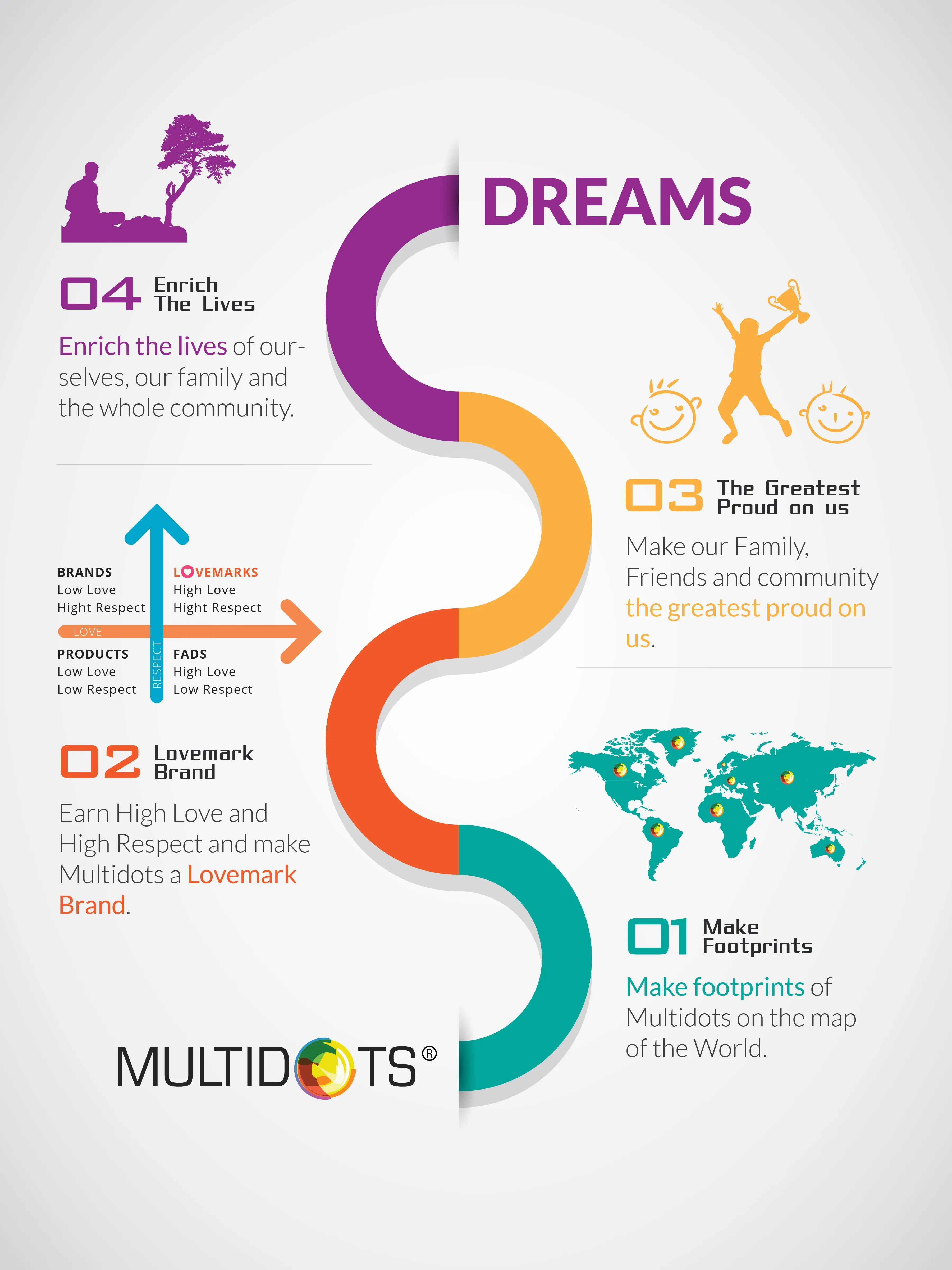How to Make Your Startup A Booming Business? Here’re The 5 Strategies You Would Need
Discover 5 key strategies to transform your startup into a booming business and drive sustainable growth

Table of Contents
In Denmark, the bride is kissed by all the single man. "Seriously?" Mine was the same reaction as yours right now when I came to know.
Likewise, when I interviewed Mr. Anil Gupta, CEO and Co-founder, and… Mr. Aslam Multani, CTO and Co-founder, Multidots, I was equally surprised with each takeaway.
Haven’t you read that wisdom:
If you want to know the value of ONE YEAR, ask a student who failed a grade.
If you want to know the value of ONE MONTH, ask a mother who gave birth to a premature baby.
If you want to know the value of ONE HOUR, ask the lovers waiting to meet.
If you want to know the value of ONE MINUTE, ask the person who just missed a train.
If you want to know the value of ONE SECOND, ask the person who just avoided an accident.
And if you want to know the value of ONE MILLISECOND, ask the athlete who won a silver medal at the Olympics.
Similarly:
If you want to MAKE YOUR STARTUP A BOOMING BUSINESS, not only read but reiterate these five strategies at every possible juncture of your startup activities.
Yes, I repeat: Reiterate These 5 Strategies At Every Possible Juncture.
Because by the end of this article, I am damn sure, you would realize that these are THE five strategies I think which can serve as the bedrock startup growth essentials.
A few weeks ago, I had a chance to interview the co-founders of Multidots because of a very special occasion (will declare very soon what special occasion that was!)
After usual morning greetings, I started with the stats: In a scenario when nine out of ten startups fail, says the article from Fortune by Erin Griffith, when the IBM and Oxford study claims that 90% of Indian startups fail within the first five years, and when 92% of 3,200+
In a scenario when nine out of ten startups fail, says the article from Fortune by Erin Griffith, when the IBM and Oxford study claims that 90% of Indian startups fail within the first five years, and when 92% of 3,200+ high growth web/mobile startups failed within 3 years says the most comprehensive analysis report Startup Genome Report Extra on Premature Scaling – what do you think is the biggest missing link in startups?"No Product Innovation," Mr. Aslam Multani, the technical face of Multidots, said instantly.
"No Product Innovation," Mr. Aslam Multani, the technical face of Multidots, said instantly. I asked for an explanation about it.
I asked for an explanation about it. Then he said, "Take any startup. Any damn startup. Everyone wants to move from point A to point B. And Multidots too is not an exception from that. With that mind-frame, when I meet people and hear their ideas about how we can take Multidots from point A to point B, my next immediate question is, ‘Why do you think this is an excellent idea to work upon?’ ‘Is there any research you have done that supports your idea/hypothesis?’"
Then he said, "Take any startup. Any damn startup. Everyone wants to move from point A to point B. And Multidots too is not an exception from that. With that mind-frame, when I meet people and hear their ideas about how we can take Multidots from point A to point B, my next immediate question is, ‘Why do you think this is an excellent idea to work upon?’ ‘Is there any research you have done that supports your idea/hypothesis?’"It’s because a long time ago, in the initial days of Multidots, when Anil and I were discussing the products which could be the best fit for market, I came across two stories, and I still follow the ‘essence of those two stories,’ and then he narrated:
It’s because a long time ago, in the initial days of Multidots, when Anil and I were discussing the products which could be the best fit for market, I came across two stories, and I still follow the ‘essence of those two stories,’ and then he narrated:In brief:
In brief:He first talked about William Penn Adair "Will" Rogers, a famous actor from the 1940’s.
He first talked about William Penn Adair "Will" Rogers, a famous actor from the 1940’s.
Mr. Aslam said, "at a keynote speech, Will Rogers was asked, ‘how to end World War II?’"
And his response was this (he showed me that in his MacBook): "The way I see it, the problem with Germany is their submarines. You see, they have those U-boats sinking our boats. So my idea to end the war and beat Germany is simple: What we do is we heat the oceans ‘till they boil. Then it will be so hot that the U-boats will need to surface to cool off and get air. That’s when we blow them out of the water. " He continues with the following: "Now you might ask yourself; how will we heat the oceans? That’s not my problem you see, as I am just an ‘idea man’."
"The way I see it, the problem with Germany is their submarines. You see, they have those U-boats sinking our boats. So my idea to end the war and beat Germany is simple: What we do is we heat the oceans ‘till they boil. Then it will be so hot that the U-boats will need to surface to cool off and get air. That’s when we blow them out of the water. " He continues with the following: "Now you might ask yourself; how will we heat the oceans? That’s not my problem you see, as I am just an ‘idea man’."Then he talked about Aguas Danone, a bottled water company in Argentina. He said this is my all-time favorite ideal when it comes to market opportunity analysis or product innovation.
Then he talked about Aguas Danone, a bottled water company in Argentina. He said this is my all-time favorite ideal when it comes to market opportunity analysis or product innovation. In 2001, the company’s sales were fading, and so they were looking for a new product, as Argentina was undergoing its worst economic crisis in its’ history. In a sentence, the company needed to boost its revenues through new, innovative, more value-added product development. Consequently, while doing market opportunity analysis, Aguas Danone identified:
In 2001, the company’s sales were fading, and so they were looking for a new product, as Argentina was undergoing its worst economic crisis in its’ history. In a sentence, the company needed to boost its revenues through new, innovative, more value-added product development. Consequently, while doing market opportunity analysis, Aguas Danone identified:
1. Bottled water is perceived as healthy but does not offer the attribute of good taste.
2. Soft drinks and juices taste good, but are viewed as highly caloric.He asked me, "Okay, what could you have inferred out of these findings?"
He asked me, "Okay, what could you have inferred out of these findings?"I was blank. Totally blank. Couldn’t able to answer it.
I was blank. Totally blank. Couldn’t able to answer it.[Coffee arrived!]
[Coffee arrived!]"Can you imagine, Aguas Danone realized an opportunity for healthy drinks offering both taste and flavor. As a result, they launched flavored bottled waters Ser with great success," the CTO of Multidots said.
"Can you imagine, Aguas Danone realized an opportunity for healthy drinks offering both taste and flavor. As a result, they launched flavored bottled waters Ser with great success," the CTO of Multidots said. Now this is something really crazy what you’re going to read:
Now this is something really crazy what you’re going to read:
Since the launching of Ser in 2002, Aguas Danone has been the leader of Reduced Sugar Flavoured Bottled Water in Argentina. In fact, beating giants such as Coca-Cola, PepsiCo, and Nestlé.
That was shocking to know.
By the way, just for your information: Bottled water is now more popular than Pepsi and Coke.
The point is…
Having an idea for a business and having a recognizable market opportunity (on which an actionable plan that can support a profitable business) are completely different.
Takeaway 1: always, always, always,…do Market Opportunity Analysis and find what customers really want.
"It is impressive to know that a two-people agency started in May 2009 now grew over a 140+ people company. What are your thoughts about how startups should do recruiting?" I asked Mr. Anil Gupta, the thinker dot of Multidots.
In May 2009, we used to believe that there were two critical skills every startup shall have:
1. Skills for building a great product that has clear market fit as Aslam just said. And Skills for building a helping machine and so sales and marketing machine.
2. Skills for building a helping machine and so sales and marketing machine.
One thing is clear that if your startup is not helping people or businesses to solve their problems, you cannot survive. So when you desire to help people, help businesses, solve their problems, at any cost, you would need a team.
By the end of 2009, we have recruited six people. In 2010, ten. And in 2011, we brought a full-time in-house recruiter. So we got a total focus on sourcing and managing candidate flow which surely helping Multidots a lot in growing bigger and bigger. However, my involvement has always been critical as I observed the best people are almost never on the market.
The point is…
Any startup should focus on creating a culture that just doesn’t help in attracting amazing talents, but it should amplify their abilities and encourage them to do their best. This is how we become a magnet for tiptoes and passive candidates.
So now in September 2017, I believe there are three startup skills every startup shall have:
1. Skills for building a great product that has clear market fit as Aslam just said. And
2. Skills for building a helping machine and so sales and marketing machine.
3. Skills for building a company culture and so recruiting machine.
Takeaway 2: Write down. Literally write it down: "I want to Recruit Passive Candidates, and I’m ready to do whatever it takes – from building a culture to creating an employee referral policy. Iiii…WANT THE BEST TO HAPPEN, AND I’ll MAKE THAT HAPPEN!"
Of course, my next question was, "How you built such an enthralling company culture?""In reality, we had never thought about creating a culture. In fact, it was back in 2013, we engaged our employees, made clear strategies, goals, mission, vision. In a nutshell, we all could visualize what sort of company we want and how we would get there. And it just cannot happen on its own.
"In reality, we had never thought about creating a culture. In fact, it was back in 2013, we engaged our employees, made clear strategies, goals, mission, vision. In a nutshell, we all could visualize what sort of company we want and how we would get there. And it just cannot happen on its own. We gradually started to list our dreams.
We gradually started to list our dreams.

And we believed in them so much so that we focus our HR team on prioritizing it ahead of experience in who they hire.
The company culture is a byproduct of what we wanted to make a reality.
However, indeed maintaining that rich culture is so crucial that it, in fact, trumps even strategy." said Mr. Anil Gupta.
The point is…
Just like you maniacally build the product, do market analysis and recruiting, do the same with engaging your employees and creating ‘The Big Picture’ of your company.
Takeaway 3: Nothing Happens By Chance!
Hey, don’t you know that axiom, "It is Good Customer Service that can turn your startup into a booming business."
But looking at the number of clients working with Multidots continuously from last three years, I asked inadvertently: "Every startup knows and practices the best customer service. In that frame, how Multidots stands out?"
"Hmmm…that’s a very interesting point you have touched. Well, you may surprise, but from the beginning, Multidots has never strived to be a success. Yes! That’s true. NEVER! Rather Multidots has aimed to be of value. Always!" Mr. Anil Gupta said who mainly handles global clientele activities.
He further continued with an incident:
"I vividly remember, somewhere around 7 in the evening in July 2015.
We received an email from one of our clients based in the USA. He mentioned, ‘his website is not working.’ Well, though our official time is from 10:30 to 7:30 p.m., all the members – from Team Leads, Developers, BA, Sales to QA – associated with that project immediately gathered in a conference room, as soon as BA and BDM discussed with me and sent an email. Because here the website was working smoothly.
We made a call, shared the screen, and found out: the reason was caching.
That responsiveness established Magee’s perception about Multidots which is reflected in his words about Multidots when he recently visited our office:
The point is…
As a company, make a goal: I want to have customer service that is not just the best but legendary. If that’s what you’re practicing, I assure you, "your company is bound to succeed."
Takeaway 4: Seek for the value, rather for the success, because the client’s perception is your reality.
Takeaway 5: Do more than is required of you.
It was around 50 minutes the CEO and CTO of Multidots spent with me instead of half an hour they told me. Like a breeze on a beach and knife on butter. Strategies after strategies. Yes, almost as they (Mr. Anil and Mr. Aslam) visioned. People say: Multidots did it. But it wasn’t for the first time Mr. Anil and Mr. Aslam created something story-like, they are famous for such things from their schooling (I came to know from many Wed Talks at Multidots). Make the dreams a reality is a norm for them.
Are you too looking for developing your startup into a booming business as a norm? So here you have it: Five strategies to building your startup into a thriving business. This is not just something to think about. This is something to do. You may or may not agree with all five of these points, or you may feel the list is too short and that there should be at least six, eight, ten or even more points. So add to it, change it or whatever. Just do it!
Want to share:
What more points or strategies your startup is following?
What you’re looking at everyday and implementing in your routine?
What essentials of customer-centric culture have you developed and practicing?
Have a dialogue with us either through comments or via e-mail at hello@multidots.com.
Wishing you the best of growing.
Schedule a consultation call and discuss your migration requirements.
Contact Us
